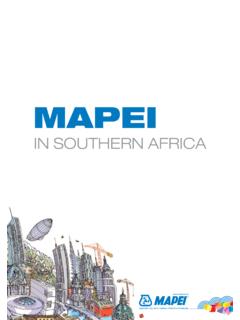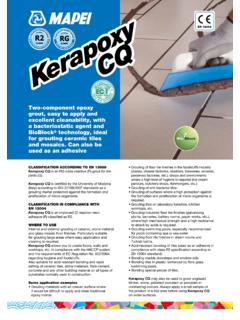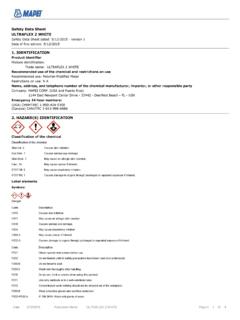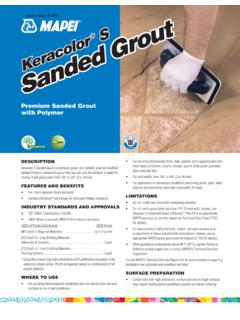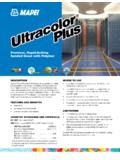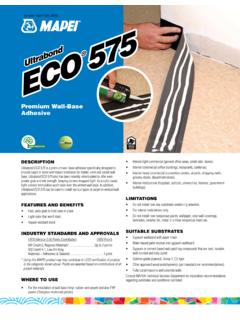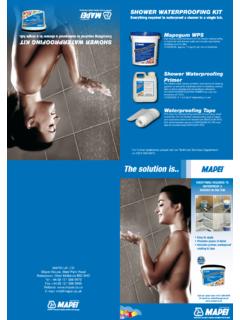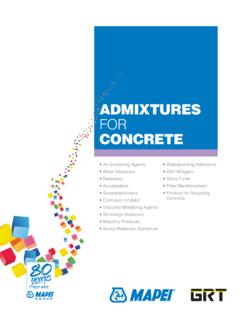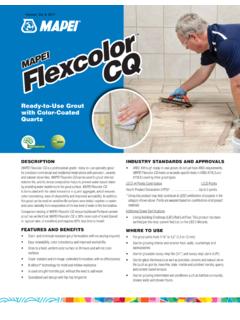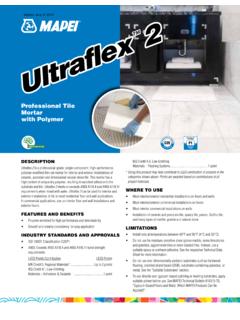Transcription of K eralastic - adhesives, sealants, chemical products for ...
1 CLASSIFICATION IN COMPLIANCE WITH EN 12004 keralastic is an improved (2) reaction resin adhesive (R) as class T is an improved (2) reaction resin adhesive (R) and slip resistant (T) classified as of keralastic and keralastic T is declared in ITT certificates n 25040320/Gi (TUM) and n 25040471/Gi (TUM) respectively, issued by the Technische Universit t M nchen laboratory (Germany).WHERE TO USEI ndoor and outdoor, bonding of wall and floor ceramic tiles, stone material and mosaics of all types on: screeds, renders, concrete, asphalt, wood, metal, PVC, reinforced polyester, asbestos-cement, gypsum, gypsum board, gypsum panels, application examples Bonding ceramic tiles, stone material and all types of mosaics in showers and on sheets used for prefabricated bathrooms. Bonding ceramic tiles and mosaics on wooden work surfaces or in kitchens in order to achieve a waterproof substrate.
2 Bonding ceramic tiles, stone material and mosaics on balconies, external terraces domes or flat roofs subject to foot traffic. Bonding natural stones and reconstructed stone (marble of every type, slate, etc.) also subject to movement and size variation due to the absorption of water (class C of size stability according to MAPEI standards). Bonding ceramic tiles and stone material on surfaces subject to vibrations and CHARACTERISTICSK eralastic and keralastic T are two-component, solvent and water free adhesives which are flexible and waterproof. They are made up of a polyurethane base (component A) and a special hardener (component B).On mixing the two components together, the result is a paste with the following properties: good workability; excellent durability and resistant to ageing; perfect adhesion to all surfaces used in building; hardens by chemical reaction without shrinkage (until it becomes highly resistant); high deformability; in the case of keralastic T, highly thixotropic: it can be applied vertically without slump and without letting even heavy or large tiles slip.
3 The slipping strength is in compliance with EN Do not use on very damp surfaces or where there is a risk of rising damp. The packs are pre-measured, therefore mixing errors are impossible. Do not use partial quantities. A wrong mixing ratio could cause damage during the curing process. Use the products in temperatures between +10 C and +30 C. In case of use on surfaces subject to continuous immersion in water, consult the MAPEI Technical Services Department beforehand. Do not use keralastic and keralastic T to bond transparent glass 12004 KeralasticKeralasticKeralastic TKeralastic T[Ceramica] 122_keralastic_gb ( - 3 Bozza/Ciano/PDF) IN COMPLIANCE WITH EUROPEAN STANDARDS REACTION RESIN ADHESIVE FOR CERAMIC TILES EN 12004 IN COMPLIANCE WITH EUROPEAN STANDARDS REACTION RESIN ADHESIVE FOR CERAMIC TILES EN 12004 andTwo-component, high-performance, polyurethane adhesives for ceramic tiles and stone materialthe layer of fresh keralastic or keralastic T is also to act as a waterproofing membrane, make sure that any ribs and lugs do not go through the keralastic or keralastic T is used for installing onto particularly deformable substrates, all coverings larger than 5x5 cm must be installed with wide open time of keralastic and keralastic T under normal temperature and moisture conditions is approximately 50 minutes.
4 Any adjustment must be carried out within 90 minutes of setting time is strictly tied to the ambient temperature (see table below).Setting time of keralastic and keralastic T in relation to the temperature:Temperature ( C)3025201510 Time (hours) 2 3 6 820 GROUTING AND SEALINGJ oints between the tiles can be grouted after 12 hours with the appropriate MAPEI cementitious or epoxy grouts, available in a variety of different joints must be sealed with the special MAPEI TO LIGHT FOOT TRAFFICF loors are set to light foot traffic after 12 FOR USES urfaces are ready for use after 7 , buckets and clothes can be easily cleaned with alcohol before hardening sets keralastic and keralastic T can be cleaned mechanically or with Pulicol of ceramics and stone material: Mosaics and small size tiles (trowel No.)
5 4): kg/m Normal size tiles (trowel No. 5): kg/m Large size tiles, marble, stones (back buttering): 5 kg/m PACKAGINGK eralastic and keralastic T are available in double metal drums of:10 kg ( kg/m component A + kg/m component B);5 kg ( kg/m component A + kg/m component B).STORAGEK eralastic and keralastic T are stable for at least 24 months when stored in sealed drums. Component B (hardener) must be stored in warm place to avoid crystallisation during cold weather (at least at +10 C). Should crystallisation occur, re-dissolve by warming before use. Stir the product before PROCEDUREP reparing the substratesThe substrates must be cured, mechanically strong, free of loose particles, grease, oil, paint, wax and be sufficiently substrates must not be subject to shrinkage after the installation of the tiles.
6 During spring and summer renders must be cured for at least one week for every centimetre of thickness and cementitious screeds must be cured for at least 28 days, unless they have been made with MAPEI special binders for screeds such as Mapecem, Mapecem Pronto, Topcem or Topcem Pronto. Where this is not observed, the adhesion of keralastic and keralastic T to the substrate will be greatly on iron surfaces must be removed by sandblasting. It is recommended to reinforce gypsum, gypsum board and anhydrite substrates with a coat of Primer EP or Primer the mixThe two components of keralastic and keralastic T are supplied in ready-to-mix cans: component A: grey or white, 94 parts by weight; component B: transparent straw, 6 parts by ratio of the resin (component A) and the hardener (component B) is fixed and any modification could cause incorrect hardening of the the hardener (component B) into component A and mix well until a uniform grey or white paste is obtained.
7 It is advisable to use a low speed electric stirrer to ensure perfect mixing and avoid overheating the mix, which would reduce the working time. Use the mix within 30-40 minutes of the mixApply to the substrate a uniform layer of keralastic or keralastic T with a notched trowel. Choose a trowel that will give a coverage to the back of the tiles of at least 65-70% (see Consumption ).For exterior installations, the tile backs must be completely covered with the both waterproofing and bonding are required, for example on wooden kitchen worktops, one of two procedures may be followed: spread keralastic on the substrate with a flat trowel to a thickness of at least 2 mm; then rework the surface with a notched trowel so as to line it all over, but without reducing the thickness to less than 1 mm. This thickness must be maintained even after the tiles have been installed, especially when the tile backs have high lugs or ribs; spread keralastic with a flat trowel to a uniform thickness of 1 mm for waterproofing and, after hardening (in any case within 24 hours), apply a second layer of keralastic with a notched the tilesTiles must be absolutely firm pressure to the tiles to ensure good contact and covering of the back.
8 If KeralasticKeralastic T KeralasticKeralastic TLaying on an old PVC floorWaterproofing and laying in a prefabricated shower unitTECHNICAL DATA (typical values)In compliance with: European EN 12004 as R2, R2T ISO 13007-1 as R2, R2 TPRODUCT IDENTITY component A component BConsistency: thick paste fluid liquidColour: keralastic white - grey straw transp. keralastic T white - grey straw (g/cm ): keralastic keralastic T solids content (%): 97 100 Brookfield Viscosity (mPa s): keralastic 800000 26 (# F - rpm ) (# 1 - rpm 50) keralastic T 1800000 46 (# F - rpm ) (# 1 - rpm 50)APPLICATION DATA (at +23 C and 50% )Mix ratio by weight:component A : component B = 94 : 6 Consistency of mix:very viscousDensity of mix (kg/m ): keralastic 1450 keralastic T 1520 Brookfield Viscosity (mPa s): keralastic 400,000 (# F - rpm 5) keralastic T 1,250,000 (# F - rpm )Pot life:30-40 minutesApplication temperature range:from +10 C to +30 COpen time (according to EN 1346).
9 50 minutesAdjustability time:90 minutesSetting time: initial: final:6 hours 8 hoursSet to light foot traffic:12 hoursReady for use:7 daysFINAL PERFORMANCESS hear adhesion strength according to EN 12003 (N/mm ): initial shear adhesion strength: shear adhesion strength after water immersion: shear adhesion strength after thermal to ageing:highResistance to solvents and oils:goodResistance to acids and alkalis:goodResistance to temperature:from 40 C to +100 CDeformability:highly deformableInstalling Carrara marble on wooden substrate with White keralastic Green Alpi marble flooring in the Rolex building hall (Bienne - Switzerland)An example of an installation of ceramic or marble on a metal structure (stairs)SAFETY INSTRUCTIONS FOR PREPARATION AND INSTALLATIONK eralastic and keralastic T component A are irritant for the eyes and and keralastic T component B are corrosive and may cause serious burns.
10 They are also harmful if inhaled. Both components of keralastic and keralastic T may cause sensitisation in those subjects sensitive to such substances. keralastic component B is also harmful when in contact with the applying the product , we recommend the use of protective gloves and goggles and to take the usual precautions for handling chemical products . If the product comes into contact with the eyes or skin, wash immediately with plenty of clean water and seek medical and keralastic T components A and B are also hazardous for aquatic life. Do not dispose of these products in the further and complete information about the safe use of our product please refer to our latest version of the Material Safety Data ONLY FOR PROFESSIONAL USEWARNINGA lthough the technical details and recommendations contained in this product data sheet correspond to the best of our knowledge and experience, all the above information must, in every case, be taken as merely indicative and subject to confirmation after long-term practical application; for this reason, anyone who intends to use the product must ensure beforehand that it is suitable for the envisaged application.
